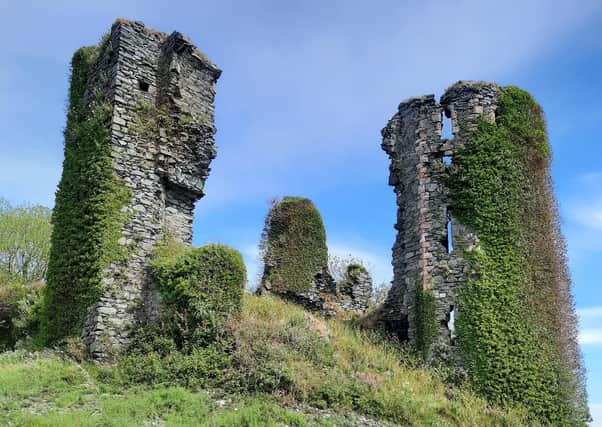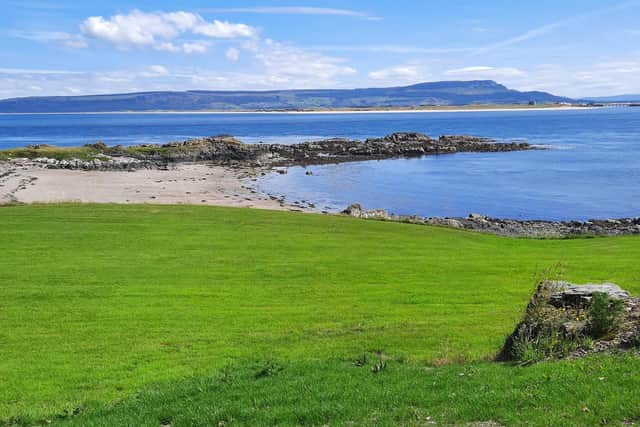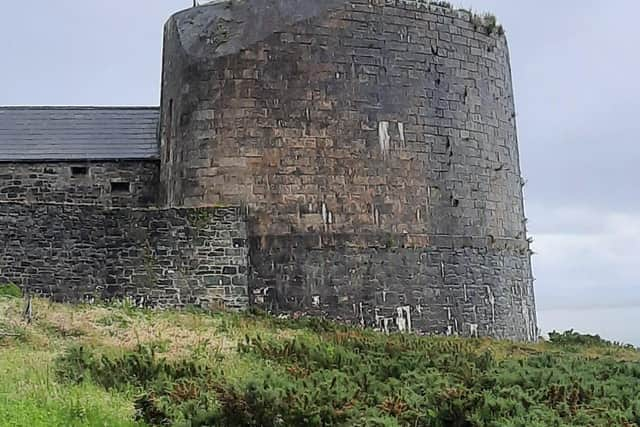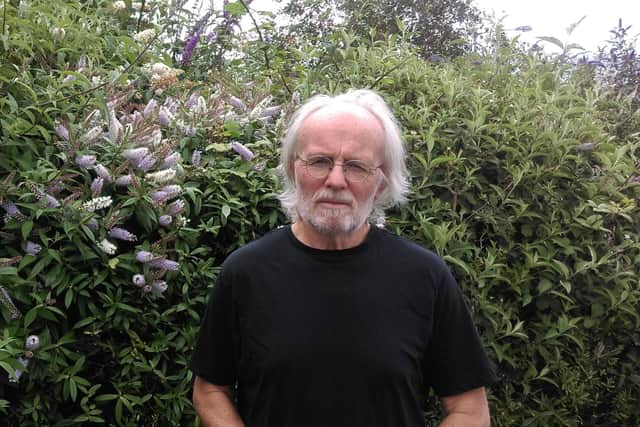Greencastle Shore Path - Ten thousand years in half an hour


Any time before 13,000 years ago the route would have been impossible unless you could walk under ice half a mile thick. Glacial conditions made human settlement impossible in Ireland but about 10,000 years ago conditions were good enough to allow people to arrive in Ireland.
For many years people have known that some of the stones they found on the small beaches around the golf course had been worked by hand. During 2011 and 2012 archaeological surveys confirmed the presence of Mesolithic, middle stone age, people from as early as 9,000 years ago. At that time Ireland would have been covered by a huge forest of oak and ash trees extending from the tops of the mountains to the shoreline. These first Irish people did not penetrate the forest but remained along the shores of the sea and large rivers. They were hunter gatherers. Avoiding bears and wolves, they hunted hares and wild boar. They were able to find plenty to eat along the shore. This included the salmon making their way up the Foyle. They could also harvest the many shell fish in the rocks along the shore path. When the Lockdown lifts we will be able to sample the same grub at Kealey’s seafood restaurant, the fish and chip shop and McLaughlin’s cafe in the village.
Advertisement
Hide AdAdvertisement
Hide AdThe Mesolithic people came for their summer holidays, did a bit of fishing,rough camping, barbecuing and left again. Neolithic people arrived 6,000 yeas ago. They were here to stay. They were farmers who brought new skills. They grew crops and cared for the cattle and sheep they brought with them. They had new skills in house building, pottery and weaving. Their society was sophisticated enough to build many impressive monuments. Older than the pyramids,the most famous is Newgrange,the enormous passage tomb in Co Meath. Even more significant was their impact on the landscape. They cleared the forests for their farms and villages. Over time this led to the landscape we have today, not just around Greencastle but all over Ireland. There are less trees here than anywhere else in Europe.


The introduction of cattle had a huge impact. They provided meat, milk and leather. We know that by the time of the Iron Age beginning around 500 BC, they were used in every form of trade, to pay fines and dowries. Our history is not just to be found in archaeological finds and ancient monuments, it is contained in the language we still use to name and describe places. The shore walk is in the townland of Eleven Ballyboes. A strange mixture of English and Irish. The Irish name for the townland is Baile Bó Deág, the homeplace fit to support 11 cows. The great Irish playwright, Brian Friel, lived in Greencastle for many years. He was well aware of the cultural importance of placenames in writing his play Translations.
The shore path takes us along the Foyle. In mythology it is the home of Mannanán mac Lir the god of the underworld.
St Patrick arrived in Ireland in the fifth century. He gave Mannanán and any other pagan gods he encountered the most ferocious kicking. St Patrick and other missionaries had a huge impact in leading a cultural transformation in religion, literacy and art – the age of ‘saints and scholars’. Looking out from the shore walk in 562 you would have seen St Columcille leaving the Foyle for Iona to export this vision to Scotland. He was followed by a series of successful away fixtures led by other Irish saints: St Aidan, St Columbanus and St Brendan. They travelled to England, northern Europe as far as Prague and Bobbio in northern Italy. Irish monks reached Iceland and possibly America. Like the European Champions League, there were return fixtures. In 790 the Vikings sailed up the Foyle in their longboats to attack the monastery at Derry. They took the cup and any other silverware they could find. In one of the few instances of anyone in Ireland praying for bad weather, a poem in old Irish found at St Gallen in Switzerland but written by a monk in Ireland expresses the dread these hooligans caused: Is Acher in gáíth in-anocht -
The wind is fierce tonight, it tosses the sea’s white mane.


Advertisement
Hide AdAdvertisement
Hide AdMy fear is the coursing of the quiet sea by the fierce warriors of Lochlend
The Vikings left their mark in Donegal. McLaughlin is probably the commonest name in Greencastle, The McLaughlins take their name from the Irish for Viking, The chiefs of the McLaughlins were the dominant force in Inishowen at the end of the first millennium. Some were recognised as An Ard Rí , the high king of Ireland. Their power declined after their fortress the Grianan of Aileach was destroyed by O’Brien king of Leinster in 1101. Meanwhile the Vikings were doing what they did best, invading. Normandy in France was followed in 1066 when their successors conquered England. The Normans were initially invited but ultimately not welcomed when they arrived in Ireland in 1169. In 1310 the Norman baron Richard Óg de Burgo built his castle known as Norburg castle. The ruins of his work still dominate the shore path today. Like all Norman castles they were designed to petrify and dominate the natives by their size and impregnability. The Normans had generally integrated with the local population wherever they went. In Ireland they adopted what we would recognise as a far more racial approach. As good Christians they had to find some justification for their scant regard for commandments six and eight.
Architectural sophistication masked the thuggery typical of all supposedly civilising colonial enterprises. In 1316 Edward de Burgo captured his cousin Walter de Burgo, starving him to death in the dungeons of the castle. Walter’s sister, Gylie de Burgo, organised Edward’s assassination a year later. Politics has always been a rough sport.
These family tiffs weakened the Norman power. Worse was to follow for the whole Norman enterprise. The Black Death spread to Ireland in 1348. It was much more severe than the Coronavirus. The population fell from 2.1 million to 1.7 million in a few short years. The Norman population was so badly diminished that English power retreated to the Pale around Dublin. The Irish chiefs reasserted themselves. The O’Dohertys, a very common local name, became the dominant force in Inishowen.


Advertisement
Hide AdAdvertisement
Hide AdThe historic comings and goings up and down the Foyle were to continue. The Tudor conquest progressed during the later half of the 16th Century. The colonial mindset was to continue. James 1 began the Plantation of Ulster in 1609. Ireland was finally lost and won (again) in 1689 when the Mountjoy sailed past the shore path on its way to break the boom and end the Siege of Derry.
There were ships that never came. The other obvious land mark on the shore walk is the Martello tower and its near twin at Magilligan. During the United Irishman Rebellion Wolfe Tone had been part of a large French fleet which set out to attack Ireland in 1796 but had been beaten back by bad weather. Around 1812 this led to 80 Martello towers been constructed to more or less the same plan all round Ireland. They were built to repulse any attack from Napoleon’s navy. Puzzlingly Napoleon had no ships and everybody knew it. The French fleet had been destroyed at Trafalgar in 1807 by Admiral Lord Nelson. Why were the towers built if no one was coming? Was it a case of paranoia - be sure to be sure? More than likely somebody, not for the last time, made a financial pile out of a pile of stones arranged impressively but serving no purpose.
Historic events and characters are never completely buried. The current ‘Black Lives Matter’ protests, sparked by the killing of George Floyd in Minneapolis, has led to questioning the reputations of many otherwise unchallenged heroes.
Among these is Horatio Nelson, the victor at Trafalgar. His statue in Trafalgar Square remains intact. His advocacy of the transatlantic slave trade, which probably brought George Floyd’s ancestors to America,has left his reputation severely tarnished.
Advertisement
Hide AdAdvertisement
Hide AdIn the past few years cruise ships dock at Greencastle. The passengers are brought ashore by smaller launches. The same system worked in reverse from 1845 onwards. There could not be a greater contrast between these two groups of people. During the time of An Gorta Mór, the Famine, desperate people from all over the north of the island were brought from Derry in small craft. They transferred into the ‘coffin ships’ heading across the Atlantic to Canada and America.
The natural cause of the problem was potato blight. There were resources available to avoid disaster but the government failed to act. Racism was at the root of the tardiness and inadequacy of the government reaction.
The great events of the following years: two world wars, revolution, partition and the Troubles all had their impact. For me the Famine is a an appropriate place to stop as my own family history is connected to it.
The scale of the Famine disaster is difficult to imagine. While the rest the world’s population increased, Ireland’s decreased from 8 million to only 4 million from 1845 to 1900. Two million died from starvation or disease caused by hunger. A further 2 million were forced to emigrate. Statistics for our pandemic are just as meaningless as those for the Famine. Every death was a disaster, each leaving a heartache. Among those emigrants were my grandparents. They headed for the coal mines, chemical works and ship yards of north east England.
Advertisement
Hide AdAdvertisement
Hide AdLike any walk, the shore path is made more interesting by thinking about those who took the same route in the past.
There were saints, scholars and villains among them. Most were like ourselves, trying to survive as best they could. No doubt like us they were looking to better days ahead.
The shore walk is not unique but there must be few places where 10,000 years can be compressed into a half hour stroll.